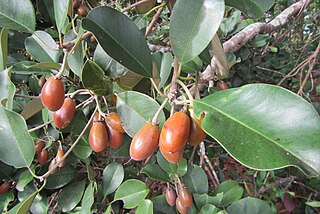
Manilkara bidentata is a species of Manilkara native to a large area of northern South America, Central America and the Caribbean. Common names include bulletwood, balatá, ausubo, massaranduba, quinilla, and (ambiguously) "cow-tree".

Manilkara is a genus of trees in the family Sapotaceae. They are widespread in tropical and semitropical locations, in Africa, Madagascar, Asia, Australia, and Latin America, as well as various islands in the Pacific and in the Caribbean. A close relative is the genus Pouteria.

Manilkara zapota, commonly known as sapodilla, sapote, chicozapote, chico, chicle, naseberry, or nispero, among other names, is a long-lived, evergreen tree native to southern Mexico, Central America and the Caribbean. An example natural occurrence is in coastal Yucatán in the Petenes mangroves ecoregion, where it is a subdominant plant species. It was introduced to the Philippines during Spanish colonization. It is grown in large quantities in Mexico and in tropical Asia including India, Pakistan, Thailand, Malaysia, Cambodia, Indonesia, Vietnam, Bangladesh.
Manilkara cavalcantei is a species of plant in the family Sapotaceae. It is endemic to Brazil, where it is threatened by habitat loss.

Manilkara dardanoi is a tree species in the sapodilla family. It is endemic to Brazil, and only found in a small portion of Pernambuco. Here it grows in forests mostly along the coast, or elsewhere deeper inland where there is old secondary forest. Its natural habitat is gradually disappearing as forest is felled and land is cleared for human settlement.
Manilkara decrescens is a species of plant in the family Sapotaceae. It is endemic to Brazil, and is threatened by habitat loss.
Manilkara elata, also called the cow tree, is a species of plant in the family Sapotaceae. It is Endemic to the Amazon region in Brazil, where it is endangered by habitat loss.
Manilkara excelsa is a species of plant in the family Sapotaceae. It is endemic to Brazil, and threatened by habitat loss.
Manilkara excisa is an endangered species of tall tree in the sapodilla family. It is endemic to the extremely steep, forested limestone hills of Trelawny, Cockpit Country and St. James parishes in Jamaica, where, although it is highly prized for its wood, it is threatened by habitat loss.
Manilkara kanosiensis is a species of tree in the sapodilla family. It is thinly dispersed in low-lying rainforests over a large range, from the Maluku Islands of Indonesia to the Bismarck Archipelago of Papua New Guinea. It is endangered by the furious pace of logging in its native habitat, where it is felled as timber.

Manilkara longifolia, commonly known as masseranduba, is a species of plant in the family Sapotaceae. It is endemic to Brazil, where it is threatened by habitat loss.
Manilkara mayarensis is a plant species in the family of sapodillas, which grows wild only in Cuba's Oriente Province. Here its members range in scale from shrubs to small trees. Its usual haunts are along creeks, ravines and other naturally formed watercourses within its montane, serpentine shrubwood habitat.
Manilkara nicholsonii is a species of plant in the family Sapotaceae. It is endemic to South Africa (Natal), and is threatened by habitat loss.
Manilkara paraensis is a species of plant in the family Sapotaceae. It is endemic to Brazil, where it is threatened by habitat loss.
Manilkara pleeana, the zapote de costa, is a species of plant in the family Sapotaceae. It is endemic to Puerto Rico.
Manilkara rufula is a species of tree in the Sapodilla family. It is endemic to the northeastern submontane forests of Bahia, Sergipe, Pernambuco, Paraíba, Ceará and Piauí states of Brazil. Although this species exists in many places, where it occurs it is either not numerous, or its numbers are declining due to loss of habitat.
Manilkara spectabilis is an uncommon species of tree in the sapodilla family.
Manilkara subsericea is a species of plant in the family Sapotaceae. It is endemic to Brazil, and threatened by habitat loss.
Manilkara valenzuelana is a species of tree or tall shrub in the Sapodilla family. It is found in coastal and subcoastal semi-deciduous forests of Cuba, the Dominican Republic, Haiti, and possibly Puerto Rico. Its habitat has been declining rapidly under pressure from charcoal makers, logging, and the clearing of forest for human habitation.

Manilkara kauki is a plant in the subfamily Sapotoideae, and the tribe Sapoteae of the family Sapotaceae; and is the type species for the genus Manilkara. It occurs in tropical Asia from Indo-China to Malesia ; and also in northern Queensland in Australia. In Java, the plant is called sawo kacik, and is associated with the royal Javanese ritual. In India, the fruit is called adão in Konkani. Throughout the world it is known generally by the name caqui, but in Australia it is called wongi.






